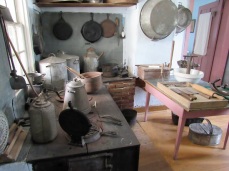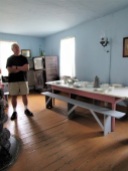Day 19, Friday, August 3, 2018
Herbert Hoover isn’t a President I know much about. In fact, I didn’t even know about the Herbert Hoover Birthplace National Historic Site, and kind of stumbled upon it by accident. I saw the road sign as I was driving east after visiting the Amana Colonies and had enough time to stop before it closed for the day; I arrived just before 4pm. What an unexpected treat!
Hoover was born to Quaker parents in a small two-room cottage in West Branch, Iowa on August 10, 1874. He was orphaned at the age of nine, when his mother died at age 35 (his father had died in 1880 at the age of 34, when Herbert Hoover was 6). He and his two siblings were split up after his mother’s death, each living in a different relative’s home; Hoover was sent to Oregon at the age of 11 to live with a maternal uncle and aunt.
The Herbert Hoover Birthplace NHS preserves the two-room cottage where Hoover was born, as well as several other sites significant to his early childhood. His father’s Blacksmith Shop (rebuilt a little west of the original site), the Schoolhouse, and the Quaker Friends Meetinghouse, where the family worshiped, have all been preserved. It is unknown if Hoover attended school in the actual building at the site, although it was being used as the primary school at the time Hoover was in school in West Branch, having been built in 1853. The Blacksmith Shop was built in 1957, representing what such a shop would have been like in the 1870s. Herbert Hoover’s older brother Theodore provided sketches of his recollection of his father’s shop as well.
The Friends Meetinghouse is original to the community where Hoover’s Quaker family worshiped; it was built in 1857. The Quakers held two meetings each week to worship; men and women sat on different sides of a central partition. They worship with “silent waiting,” a form of silent worship that does not use music or sacraments, or even a paid minister delivering a sermon. When a Quaker is moved by the “inward light,” they stand and share their insight or prayers. If you become known for your inspired insights, you become a “recorded minister” and are given a seat on the benches up front with the Quaker elders. Herbert’s mother Hulda was considered a recorded minister. Quakers believe in the equality of all people, a value that Hoover embodied when he was President and during his global humanitarian work.
The site also has a Visitor’s Center with a movie about Herbert Hoover and his life, and of course, stamps for my National Parks Passport. There are also some later homes at the site; although they didn’t exist at the time that Hoover lived in West Branch, they add to the historic ambiance of the site.
A short drive away is Herbert Hoover’s grave site, along with the grave of his wife, Lou Henry Hoover. Hoover died on October 20, 1964, at the age of 90. He selected his grave site to look over his birthplace home, and chose a simple design of white marble, with a curved walkway and an American flag. Lou Henry Hoover died in 1944 and was buried in Palo Alto, CA, but was re-interred here after Herbert Hoover died. His Presidential Library is also there, although I didn’t have time to visit it that day. I’ll have to return and learn more!
It was a fascinating stop!



































